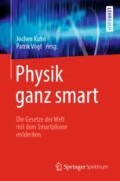Zusammenfassung
Beleuchtungsstärkesensoren (ALS = Ambient Light Sensor) werden in Smartphones und Tablet-PCs integriert, um durch eine Messung des Umgebungslichtes die Bildschirmhelligkeit des Geräts an diese anzupassen. Mithilfe spezieller Apps kann die Beleuchtungsstärke in Echtzeit angezeigt oder auch zeitabhängig dargestellt werden. In diesem Beitrag wird ein Versuch dargestellt, der den ALS eines Tablet-PCs nutzt, um die Abstrahlungscharakteristik I(ϑ) eines Smartphones zu ermitteln.
Access this chapter
Tax calculation will be finalised at checkout
Purchases are for personal use only
Notes
- 1.
Für das Experiment lässt man sich den Betrag des Flussdichtevektors ausgeben oder bestimmt diesen aus den einzelnen Komponenten \( \left( {B = \sqrt {B_{x}^{2} + B_{y}^{2} + B_{z}^{2} } } \right) \).
Literatur
Klein, P., Kuhn, J., & Müller, A. (2015). Naturwissenschaften im Unterricht Physik, 26(145), 36–38.
Klein, P., Kuhn, J., Wilhelm, T., & Lück, S. (2014). Beleuchtungsstärken mit AndroSensor messen. Physik in Unserer Zeit, 45(4), 201–202.
Molz, A., Klein, P., Gröber, S., Kuhn, J., Müller, A., & Frübis, J. (2014). Tablet-PCs als Experimentiermittel im Oberstufenunterricht – Experimente aus Optik und Kernphysik. Praxis der Naturwissenschaften – Physik in der Schule, 63(6), 27–32.
https://play.google.com/store/apps/details?id=imoblife.androidsensorbox&hl=de.
Klein, P., Kuhn, J., & Müller, A. (2015). Abstandsgesetz einer Punktlichtquelle. Naturwissenschaften im Unterricht Physik, 26(145), 39–40.
Klein, P., Hirth, M., Gröber, S., Kuhn, J., & Müller, A. (2014). Classical experiments revisited: Smartphone and tablets as experimental tools in acoustics and optics. Physics Education, 49(4), 412–418.
Mak, S. (2003). Experiments: Using infrared emitting diodes. Physics Education, 38(2), 103–107.
Mak, S. (2004). A multipurpose LED light source for optics experiments. The Physics Teacher, 42(9), 550–552.
Catelli, F., Giovannini, O., & Bolzan, V. D. A. (2011). Estimating the infrared radiation wavelength emitted by a remote control device using a digital camera. Physics Education, 46(2), 219–222.
Kuhn, J., & Vogt, P. (2012). Diffraction experiments with infrared remote controls. The Physics Teacher, 50(2), 118–119.
Demtröder, W. (2013). Experimentalphysik 2. Elektrizität und Optik. Berlin: Springer Spektrum.
Tränkler, H.-R., & Reindl, L. M. (2014). Sensortechnik. Handbuch für Praxis und Wissenschaft. Berlin: Springer Vieweg.
Free HD Compass (kostenlos). https://itunes.apple.com/de/app/free-hd-compass/id378697811.
P.M. Planetarium für iPad – Astronomie, Sterne & Planeten von P.M. und GoSkyWatch (kostenlos). https://itunes.apple.com/de/app/p.m.-planetarium-fur-ipad/id364209241.
Silva, N. (2012). Magnetic field sensor. The Physics Teacher, 50, 372–373.
Vogt, P. (2014). Tablet-Computer als Mess- und Experimentiermittel im Physikunterricht. In A. Bresges, L. Mähler & A. Pallack (Hrsg.), Unterricht mit Tablet-Computern lebendig gestalten. (Themenspezial MINT) (S. 66–78). Neuss: Verlag Klaus Seeberger.
Tesla Field (0,89 EUR). https://itunes.apple.com/de/app/tesla-field-meter/id351080302.
Internetenzyklopädie Wikipedia, Stichwort „Tesla (Einheit)“. http://de.wikipedia.org/wiki/Tesla_(Einheit).
Gröber, S., Molz, A., & Kuhn, J. (2014). Using smartphones and tablet PCs for ß–spectroscopy in an educational setup. European Journal of Physics, 35(6), 065001.
Molz, A., Klein, P., Gröber, S., Kuhn, J., Müller, A., & Frübis, J. (2014). Experimente aus Optik und Kernphysik – Tablet-PCs als Experimentiermittel im Oberstufenunterricht. Praxis der Naturwissenschaften -Physik in der Schule, 63(5), 27–32.
Kuhn, J., Molz, A., Gröber, S., & Frübis, J. (2014). iRadioactivity – Possibilities and limitations for using smartphones and tablet PCs as radioactive counters – Examples for studying different radioactive principles in physics education. The Physics Teacher, 52(6), 351–356.
Kuhn, W. (2000). Handbuch der experimentellen Physik: Sekundarbereich II. Bd. 9: Kerne und Teilchen I. Köln: Aulis Verlag Deubner & Co. KG.
Klein, R.-D. App, verfügbar im Google Play Store. https://play.google.com/store/apps/details?id=com.rdklein.radioactivity und im Apple App Store unter https://itunes.apple.com/de/app/radioactivitycounter/id464004677?mt=8.
Leybold. Fensterzählrohr für α-, β-, γ- und Röntgenstrahlung mit Kabel, Nr. 55901.
Leybold. Zählgerät S, Nr. 575471.
Eckert & Ziegler. Sr-90-Strahler.
Molz, A., Kuhn, J., Gröber, S., & Frübis, J. (2014). iRadioactivity – Untersuchung mit Smartphones & Co. Unterricht Physik, 2014(141/142), 44–51.
Kuhn, W. (2000). Handbuch der experimentellen Physik: Sekundarbereich II. Band 9: Kerne und Teilchen I. Köln: Aulis Verlag Deubner & Co. KG.
Leybold. Cs/Ba-137m-Isotopengenerator, 370 kBq (Nr. 559815).
Leybold. Fensterzählrohr für α-, β-, γ- und Röntgenstrahlung mit Kabel (Nr. 55901).
Leybold. Sensor-Cassy (Nr. 524013), GM-Box (Nr. 524033), Cassy Lab 2 (Nr. 524220).
Author information
Authors and Affiliations
Corresponding author
Editor information
Editors and Affiliations
Rights and permissions
Copyright information
© 2019 Springer-Verlag GmbH Deutschland, ein Teil von Springer Nature
About this chapter
Cite this chapter
Vogt, P., Klein, P., Gröber, S., Thees, M. (2019). Von Licht über Magnetfeld bis zur Radioaktivität. In: Kuhn, J., Vogt, P. (eds) Physik ganz smart. Springer Spektrum, Berlin, Heidelberg. https://doi.org/10.1007/978-3-662-59266-3_6
Download citation
DOI: https://doi.org/10.1007/978-3-662-59266-3_6
Published:
Publisher Name: Springer Spektrum, Berlin, Heidelberg
Print ISBN: 978-3-662-59265-6
Online ISBN: 978-3-662-59266-3
eBook Packages: Life Science and Basic Disciplines (German Language)

